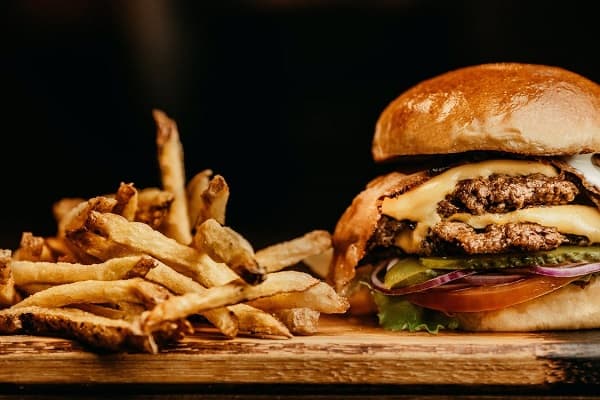The keto (short for ketogenic) diet is a low carb, high healthy fat diet that has been shown to provide numerous benefits. Not only can it aid in weight loss, but it can also improve your overall health and well-being. Keto can be an effective way to manage blood glucose levels (perfect for diabetics), reduce blood pressure levels, satiate appetite, and even help to manage epilepsy and (potentially) cognitive decline.
With so many benefits, it’s no wonder that keto is arguably the most popular diet in the United States. Whether you’re looking to shed some weight, improve your overall health – or both – if you’re thinking about jumping on the keto diet bandwagon, there’s no doubt you have some questions you’d like answered.
Read on for an overview of the ketogenic diet for beginners.
Keto Quick Guide for Beginners

If you don’t have time to read through this quick(ish) overview, but you’d like the basics of keto, this section is for you. Here, we offer a quick keto diet guide.
What is the keto diet?
The ketogenic diet (or just ‘keto’ for short) is an approach to eating in which you pay close attention to your macronutrient intake. Specifically, you aim to restrict your carbohydrate intake (typically to less than 20g of carbs per day), aim to get a sufficient amount of protein, and get the majority of your calories from healthy fats. It’s a little more complicated than that, but that’s the general gist.
This is why keto is often referred to as a low-carb, high-fat (LCHF) diet.
The objective is to get your body to maintain a long-term state of ketosis in which you burn fat instead of carbs for energy. Generally speaking, this will help you lose weight and eventually lead to the health benefits mentioned above.
What are macronutrients?
The three primary macronutrients are carbohydrates, fats (also known as lipids), and protein.
When doing keto, you’re going to hear the term “macronutrients” a lot. These macronutrients are the organic molecules that the body metabolizes (i.e., breaks down and transforms) to generate energy and build tissue. They are the building blocks of life.
What are ketones?
Ketones are metabolites produced by the liver when it breaks down fat. Ketones can be used by your cells to produce energy (in specialized cell structures called mitochondria) in place of glucose.
You’ll also hear plenty about ketones when doing keto.
What is ketosis?
Ketosis is a metabolic process that occurs when the body doesn’t have enough stores of glucose to produce energy. Instead, it burns the fats it has available to it (either stored fats or the ones you eat at each meal). In metabolizing fats, ketones are produced, which are the molecules that your cells use to create the energy they need to do their specialized jobs.
What to eat on the keto diet?
Essentially, the keto diet involves strictly eating foods that are low in carbohydrates, have sufficient amounts of protein to meet your specific target, and contain enough fats to support your energy needs. Because the keto diet can be relatively strict, it’s a good idea to do keto meal prep each week, especially for lunches.
Examples of keto-friendly foods include:
- Lean cuts of meat; preferably organic and grass-fed.
- Fatty fish, such as mackerel, tuna, and salmon.
- Eggs
- Dairy products such as cream, cheese, yogurt, and butter
- Nuts and seeds, like chia seeds, pumpkin seeds, walnuts, and almonds
- Healthy oils, such as coconut oil, extra virgin olive oil, and avocado oil
- Low carb fruits and keto veggies, like leafy greens, broccoli, avocados, tomatoes, and most berries.
You may be looking at that list and thinking “great, but I can’t just eat most of those things straight”. And you’re right. This is one of the most challenging parts of the keto diet: Combining keto-approved ingredients into foods you actually want to eat. It’s actually why this website was created. We scour the internet looking for the best keto recipes and then compiling them into easy-to-follow round-ups.
Here are some of our best:
| General Recipes | |
| Breakfast Recipes | |
| Lunch Recipes | |
| Dinner Recipes | |
| Dessert and Sweets Recipes | |
| Libations, Snacks and Condiments |
What foods should you avoid?

You should avoid high-carb and heavily processed foods, such as:
- Grains and grain-based products, especially refined ones, like bread, rice, pasta, and cereals
- Junk foods, like chips, cookies, and crackers
- Sweets, such as candy, soda, fruit juices, and ice cream
- Starchy fruits, such as bananas and apples
- Starchy vegetables like potatoes, yams, and carrots
- Beans and legumes, such as lentils, kidney beans, and chickpeas
- Processed fats that are high in trans fat, such as many store-bought mayonnaises, processed vegetable oils, and margarine
- Low-fat, sugar-free, and diet foods and drinks (because they often have undesirable chemicals in them that have relatively unknown effects on the body and its metabolic processes
With the information presented in the above brief keto guide, you should have a basic understanding of this popular and highly effective diet. It really isn’t a difficult diet, as there are plenty of food options; however, it does require diligence. With the proper information, preparation, and dedication, you should be able to successfully achieve your weight loss goals and reap the benefits that the keto diet provides.
Get Started on the Ketogenic Diet: How to Eat Keto

It’s obvious but also bears repeating: In order to achieve success with the keto diet (or any diet), you need to make significant and lasting changes to the way you eat.
In that regard, getting started on the keto diet is as simple as this:
|
Macronutrient intake |
What it means |
|---|---|
|
Low Carbohydrate |
|
|
Sufficient Protein |
|
|
Adequate Fat |
|
You may notice that we talk in terms of grams of each macronutrient. Some other keto sources will talk about macro intake in terms of percentage of calorie intake. This is a ‘horses for courses’ thing. The percentage model of ketogenic diets was designed for therapeutic uses, namely in treating neurological disorders like drug-resistant epilepsy. In these instances, maintaining strict ketone levels is extremely important, and ratios or percentages are better for this. We’re assuming that you’re like most people doing the diet, and that your aim is weight loss. In this instance, grams of macros is recommended as it’s easier to understand and manage.
In either case, you should consult a qualified health professional like your doctor before starting any diet.
For your body to enter ketosis, lose weight, and reap the health benefits that the ketogenic diet can provide, you must establish a plan and be diligent about sticking to that plan. Here are some simple tips that you can use when you’re starting the keto diet.
Determine your caloric intake
This will then allow you to determine more precisely how much fat, protein, and carbs you should be eating on a daily basis. You can use a keto calculator to assist in determining this. A reliable, high-quality, and easy to use keto calculator can be found at ruled.me. There’s also this more simple one from calculo.io
Be strict with your macros, especially your carb and protein intake
Once you have determined your necessary macro intake using a keto calculator, you need to be strict with these numbers. Especially the carb and protein figures.
A concept you should understand at this point is limits and targets for your macros.
Limits
Your daily carb intake in grams is a limit. You should not exceed the number, but you don’t have to reach the number either. If you’re under your carb intake for the day, you don’t need to scoff a banana or start baking muffins.
By severely limiting the number of carbohydrates you ingest, your body will enter the metabolic process of ketosis (described above). Once you enter ketosis your body will naturally use fats for energy by turning them into glycerol and fatty acids and then synthesizing these elements into ketones (the highly efficient energy molecules).
Targets
Your daily protein intake is a target. You should try and meet this number every day.
While keto is often talked about in terms of fat and carbs, protein is arguably the most important macronutrient. This is because proteins (or more specifically, amino acids) are used to build and maintain basically all of our body’s tissues: Muscle, bone, cartilage, ligaments and tendons, and neural tissue. Even our blood and hormones are partially made from proteins.
Unlike fat and carbs, our bodies don’t store protein. We use it or lose it. But, because protein is so vital to building and repairing our tissues if we don’t have enough of it our bodies start to break down certain less vital tissues to liberate the protein for use in building and repairing more vital tissues.
Skeletal muscle is a less vital tissue. Cardiac muscle and brain cells are more vital tissue. When you don’t get enough protein on any diet, but especially on keto, you will likely experience skeletal muscle degeneration which occurs to be able to maintain vital organs like your heart and brain.
Is fat a limit or target?
Neither. Fat will typically make up a good portion of your caloric intake, but you don’t necessarily need to hit the target or stay strictly under the limit. Fat will help you feel more full, as well as provide some of the energy you need to function throughout the day, so your intake should be relatively close to your target/limit.
Also, remember that when in ketosis your body will use the fat sources it has available to it for energy. If you don’t take in enough external fat (from the day’s food), then your body will use your internal fat stores. This is what you want if you’re aiming to lose weight. If you take in more fat from your food than your body needs day-to-day (for energy), your body will store it. That’s not what you want when trying to lose weight.
Identify the foods that will best help you achieve your specific intake, and meal plan!
Consult the list above for a quick guide to things that you can eat and things that you should avoid when you’re on the keto diet.
Here’s a more detailed, but still quick, guide.
When you’re first getting started, establishing a keto meal plan can be extremely helpful – especially for the first few weeks. Doing so will allow you to get adjusted to eating a keto-friendly diet, and once you’re more familiar with what you can safely eat and what you should avoid, you should have an easier time choosing foods that meet the keto guidelines.
One of the benefits of knowing the right foods to eat and meal planning is that it helps you prepare for some of the side effects of going keto, which is what we’ll discuss next.
Keto Diet for Beginners: Side Effects of the Ketogenic Diet

When you enter ketosis, you may experience certain unpleasant symptoms. These will subside as your body adjusts. Common symptoms reported by keto dieters include:
- General illness resembling a cold or flu (commonly called ‘the keto flu‘)
- Reduced energy levels
- Slower mental processing or feelings of fogginess.
- Sleep disruptions
- Nausea, which could lead to vomiting
- Digestive upset
- Decreased stamina
Keto for Beginners: Who Should Not Be Doing Keto?
If any of the following apply to you, you should avoid the keto diet, as it could be detrimental to your health:
- Nutritional deficiencies
- Liver problems
- Kidney problems
- Chronic constipation
- Mood swings
- Difficulty concentrating
Always consult a qualified health professional like your doctor before starting any diet.
Our Thoughts on the Keto Diet for Beginners
This keto diet guide provides a basic synopsis of the globally popular diet. The above-mentioned information – combined with preparation, determination, and dedication – you can successfully lose weight and improve your overall health and general well-being on the keto diet.

